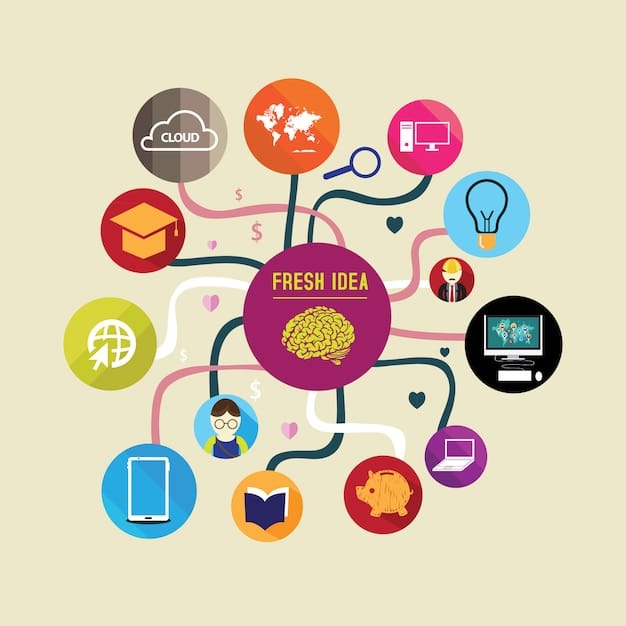Gen Z Learning: Neuroscience & Educator Implications

Gen Z’s neurological learning basis, shaped by digital immersion, presents unique cognitive processing and attention patterns, necessitating educators to adapt teaching methodologies that incorporate experiential learning, personalized feedback, and technology-rich environments to foster effective engagement and deeper understanding.
Understanding the neurological basis of learning in Gen Z: implications for educators is crucial for adapting teaching methods to suit this digitally native generation. Born into an era of pervasive technology, Gen Z exhibits distinct cognitive patterns and learning preferences that warrant a closer look from a neurological perspective. This article delves into how their brains process information, offering insights for educators aiming to foster more effective and engaging learning environments.
the developing brain and Gen Z’s digital landscape
The human brain is remarkably plastic, continuously adapting to environmental stimuli. For Gen Z, this environment is intrinsically linked to digital technology. From a young age, exposure to screens, instant information, and multi-platform content has undeniably shaped their neural architecture. This constant interaction influences circuits related to attention, reward, and information processing.
The prefrontal cortex, the area responsible for executive functions like decision-making, planning, and impulse control, continues to mature well into the mid-20s. For adolescents within Gen Z, this ongoing development is occurring alongside unprecedented digital engagement. This can lead to different neurological pathways for processing stimuli, potentially favoring rapid information intake over sustained deep processing. While concerns about reduced attention spans are often voiced, it is more accurate to consider a shift in the nature of attention—from sustained focus on a single linear task to a more distributed, multi-modal attention.
This generation thrives on immediacy and visual communication, which are traits often reinforced by social media and online gaming. Neurologically, this translates to heightened activity in areas associated with visual processing and reward pathways. Dopamine, the neurotransmitter linked to pleasure and motivation, is frequently stimulated by instant feedback, likes, and notifications, potentially influencing how Gen Z seeks and processes new information. Educators must recognize these inherent neurological predispositions when designing curriculum and classroom activities. Understanding these foundational elements is the first step toward creating truly impactful learning experiences.
reimagining attention and engagement
Traditional models of learning often assume linear attention, where students absorb information sequentially. However, Gen Z’s neurocognitive landscape suggests a more dynamic and distributed attention style, shaped by their constant exposure to hyperlinked information and multi-tasking environments. This demands a critical re-evaluation of how engagement is conceptualized and fostered in educational settings.
This generation exhibits what some neurologists term “popcorn brain,” characterized by rapid shifts in focus and a preference for novel stimuli. While this presents challenges for sustained attention on singular, long-form tasks, it also suggests an enhanced ability to process multiple streams of information simultaneously and to quickly switch between contexts. Understanding this distinction is vital: it’s not necessarily a deficit in attention, but a different attentional mechanism.
leveraging digital fluency for deeper learning
Educators can harness this digital fluency. Incorporating interactive digital tools, gamification, and opportunities for multi-modal engagement can naturally leverage Gen Z’s accustomed cognitive patterns.
* **Interactive simulations:** Provide immediate feedback and visual stimulation.
* **Gamified learning:** Engages reward pathways, fostering motivation through achievement.
* **Micro-learning modules:** Caters to shorter attention cycles, delivering content in digestible chunks.
fostering sustained focus
While embracing their digital nature, it’s also important to cultivate skills for sustained, deep focus. This can be achieved through structured activities that gradually extend attention spans, such as project-based learning that requires multi-stage problem-solving, or focused reading sessions followed by reflective discussions. The goal is a balanced approach that validates their innate learning styles while also developing critical skills for complex problem-solving. By thoughtfully integrating varied approaches, educators can bridge the gap between Gen Z’s neurological preferences and the demands of intricate academic content.

the role of reward systems and motivation
The brain’s reward system, primarily involving the neurotransmitter dopamine, plays a significant role in learning and motivation across all ages. For Gen Z, who have grown up with instant gratification embedded in their digital lives, this system may respond differently to traditional educational incentives. Understanding this dynamic is key to designing effective motivational strategies.
Constant notifications, social media likes, and immediate feedback from online games stimulate dopaminergic pathways, creating a neural expectation for rapid, short-term rewards. This can make traditional, delayed rewards in academia, such as grades or long-term project outcomes, seem less immediate and therefore less compelling. The brain learns to associate quick actions with quick pleasures.
designing intrinsic motivation
Educators should explore how to harness these reward mechanisms for academic gain, moving beyond extrinsic motivators.
* **Immediate constructive feedback:** Provides quick validation and direction, satisfying the need for rapid response.
* **Personalized learning paths:** Offers a sense of autonomy and achievement as students see direct progress in areas of interest.
* **Gamification elements:** Integrates points, badges, and leaderboards to tap into the competitive and achievement-oriented aspects of digital culture.
* **Real-world relevance:** Connecting learning to tangible, immediate impact can activate intrinsic reward systems by demonstrating purpose.
balancing short-term and long-term gratification
While leveraging immediate rewards, it’s also crucial to cultivate an appreciation for long-term goals and the delayed gratification necessary for deeper learning. This can be achieved by breaking down large projects into smaller, rewarded milestones or by emphasizing the journey of learning alongside the final outcome. Encouraging reflection on personal growth and the cumulative mastery of skills can shift focus towards intrinsic satisfaction. Educators might facilitate discussions on how consistent effort leads to significant accomplishments, building neural pathways that value sustained commitment.
memory formation and retrieval in a digital age
Memory is fundamental to learning. For Gen Z, the constant access to information “on demand” through digital devices raises questions about how memory is being formed, stored, and retrieved. Their reliance on external memory aids (like search engines) may influence the neural processes involved in internal memory consolidation.
The brain primarily forms memories through repetition, association, and emotional engagement. While Gen Z excels at rapidly locating information, the process of deep encoding—transferring information from short-term to long-term memory—might be altered. Some research suggests that the “Google effect” or “digital amnesia” means people are less likely to remember information they know they can easily look up later, potentially impacting the development of certain memory circuits. This isn’t necessarily a memory deficit, but rather an adaptation to an environment where information retrieval is nearly instantaneous.
active recall and spaced repetition
To counteract potential shifts in deep encoding, educators can emphasize strategies that actively engage memory.
* **Frequent low-stakes quizzes:** Promotes active recall, strengthening neural pathways.
* **Spaced repetition:** Reintroduces concepts at increasing intervals, aiding long-term retention.
* **Concept mapping:** Encourages students to make connections between ideas, enhancing associative memory.
* **Problem-based scenarios:** Requires applying knowledge in novel situations, solidifying understanding and recall.
multimodal input and memory
Gen Z’s preference for visual and auditory input can be leveraged for memory. Presenting information in diverse formats (videos, podcasts, interactive diagrams) uses multiple sensory pathways, which can enhance memory consolidation. The brain creates richer, more interconnected memory traces when information is experienced through various channels. By intentionally designing learning experiences that require students to actively process, synthesize, and apply information rather than merely consume it, educators can help strengthen their internal memory capabilities, ensuring that knowledge is truly retained and readily accessible.
social learning and collaborative neuroscience
Gen Z is inherently social, extensively using digital platforms to connect and collaborate. This strong social orientation has profound implications for how their brains engage with learning within a group context. Social interaction is a powerful catalyst for neural development and learning, fostering empathy, communication skills, and diverse perspectives.
From a neurological standpoint, collaborative learning activates brain regions associated with social cognition, joint attention, and empathy. When students work together, they are engaging in shared problem-solving, negotiation, and reciprocal teaching, which can enhance memory encoding and critical thinking. The peer-to-peer discussions and explanations involved in group work can lead to deeper understanding by forcing individuals to articulate their thoughts, thereby solidifying their grasp of concepts.
designing effective group learning environments
To maximize the neurological benefits of social learning for Gen Z, educators should structure collaborative activities thoughtfully.
* **Clearly defined roles:** Ensures equitable participation and varied contributions within groups.
* **Technology-supported collaboration:** Utilizes platforms that Gen Z is comfortable with (e.g., shared documents, video conferencing tools) for seamless teamwork.
* **Structured reflection opportunities:** Encourages groups to analyze their collaborative process and discuss lessons learned.
* **Interdisciplinary projects:** Allows students to pool diverse knowledge and skills, simulating real-world problem-solving.
the mirror neuron system and empathy
The mirror neuron system, responsible for understanding and imitating the actions of others, is highly active during social interaction. In collaborative settings, this system contributes to empathy and shared understanding, allowing students to “feel” what others are experiencing or thinking. This neurological mechanism is crucial for developing robust social-emotional skills alongside academic knowledge. By fostering inclusive and interactive learning environments, educators can tap into Gen Z’s innate social neurology, transforming classrooms into dynamic hubs for collective knowledge construction and personal growth.

implications for pedagogical strategies
Given the distinct neurological tendencies of Gen Z, educators must adapt their pedagogical strategies to create more resonant and effective learning experiences. The traditional “stand and deliver” model is often at odds with how this generation’s brains are wired for information processing and engagement. This calls for a shift towards more dynamic, interactive, and personalized approaches.
One key implication is the need for active learning strategies. Instead of passive reception, Gen Z benefits from direct engagement with the material. This includes hands-on activities, problem-based learning, and inquiry-based projects that allow them to explore and discover rather than simply being told. Such approaches stimulate more extensive neural networks, leading to deeper understanding and better retention. Moreover, integrating multimedia and interactive elements is not just about keeping them entertained; it’s about leveraging their natural processing preferences for visual and dynamic information.
personalization and feedback loops
Personalization is another critical strategy. Gen Z thrives on individualized experiences, a preference reinforced by algorithms that tailor content to their specific interests. Academically, this translates to differentiated instruction, adaptive learning platforms, and opportunities for students to pursue topics that genuinely pique their curiosity. Immediate and constructive feedback is also paramount. The brain’s reward system, accustomed to instant digital responses, benefits greatly from timely feedback that allows for immediate course correction and reinforcement of correct pathways.
fostering metacognition and digital literacy
Beyond adapting to their preferences, educators also have a responsibility to cultivate essential metacognitive skills and responsible digital citizenship.
* **Teaching self-regulation:** Helping students understand their own learning processes and how to manage distractions.
* **Critical evaluation of information:** Equipping them with the skills to discern credible sources from misinformation in a vast digital landscape.
* **Digital well-being:** Guiding them in understanding the neurological impacts of excessive screen time and promoting balanced digital habits.
The overall goal is not to simply pander to technological habits, but to strategically leverage Gen Z’s unique neurological predispositions while also developing the executive functions and critical thinking skills necessary for lifelong learning in a rapidly evolving world.
challenges and future directions in educational neuroscience
While understanding the neurological basis of learning in Gen Z offers profound insights, it also presents significant challenges and opens new avenues for research in educational neuroscience. The rapid pace of technological change means that the very brain structures and cognitive processes we study are continuously evolving, making it a moving target for researchers and educators alike.
One primary challenge lies in bridging the gap between neuroscience research and practical classroom application. Translating complex neurological findings into actionable pedagogical strategies requires interdisciplinary collaboration between neuroscientists, educators, psychologists, and technologists. This necessitates ongoing professional development for teachers, equipping them with the knowledge and tools to implement neuro-informed teaching practices effectively. Furthermore, the ethical implications of using neuroscience to personalize education, such as potential biases in adaptive learning algorithms or privacy concerns surrounding data collection, warrant careful consideration.
the evolving nature of brain development
Future research needs to focus on longitudinal studies that track the long-term impact of digital immersion on brain development and learning outcomes. As Gen Alpha and subsequent generations emerge, their neurological landscapes will likely present new characteristics.
* **Impact of AI on cognition:** Exploring how increasing interaction with artificial intelligence affects problem-solving and creativity.
* **Neurodiversity and digital tools:** Understanding how digital environments can be optimized to support diverse neurological profiles.
* **Measuring brain plasticity:** Developing non-invasive methods to assess brain changes in response to varied educational interventions.
leveraging technology responsibly
The future of educational neuroscience for Gen Z and beyond will depend on our ability to leverage technology as a tool for deeper learning, rather than allowing it to dictate cognitive development unconsciously. This means moving beyond merely incorporating gadgets to integrating technology thoughtfully into pedagogical frameworks that align with how the brain learns best. Understanding the brain’s incredible adaptability offers hope for optimizing learning for this dynamic generation, but it requires continuous research, ethical reflection, and a commitment to innovation in educational practice.
| Key Point | Brief Description |
|---|---|
| 🧠 Digital Brain Adaptation | Gen Z’s brains adapt to constant digital input, influencing attention and information processing. |
| 🎮 Reward System Shift | Preference for immediate feedback due to dopamine-driven digital experiences. |
| 🤝 Social Learning Benefits | Strong social inclination (digitally fostered) enhances collaborative learning and empathy. |
| 🍎 Pedagogical Adaptations | Educators need active, personalized, and technology-integrated strategies to align with Gen Z’s neuro-wiring. |
frequently asked questions about Gen Z’s learning brain
Digital exposure often leads to a shift in attention style from sustained linear focus to a more distributed, multi-modal attention. Their brains are highly adapted to rapidly switch between tasks and absorb information from multiple sources simultaneously, which isn’t necessarily a deficit but a different way of processing.
“Popcorn brain” describes the tendency for Gen Z to exhibit rapid shifts in focus, often preferring novel stimuli and quick feedback. This is believed to be influenced by constant stimulation from digital devices, where content changes rapidly, and new notifications provide immediate bursts of information.
Educators can leverage this by providing immediate, constructive feedback on assignments, incorporating gamification elements with tangible rewards (like points or badges), and offering personalized learning paths that show immediate progress. Connecting learning to real-world, tangible outcomes also stimulates quicker reward responses.
While constant access to information can reduce the perceived need to deeply encode facts (known as the “Google effect”), it doesn’t necessarily impair memory. Educators can encourage active recall, spaced repetition, and concept mapping to strengthen long-term memory formation, ensuring information is stored meaningfully, not just accessed externally.
Collaborative learning engages brain regions linked to social cognition and empathy, fostering deeper understanding. Peer-to-peer discussions, shared problem-solving, and reciprocal teaching activate varied neural pathways, enhancing memory encoding and critical thinking through articulation and diverse perspectives, leveraging their natural social inclinations.
conclusion
Understanding the neurological basis of learning in Gen Z offers a powerful lens through which educators can refine their methods. This generation’s brains, shaped by an immersive digital landscape, exhibit distinct patterns in attention, reward processing, and memory. By embracing active learning strategies, leveraging technology for engagement, and fostering metacognitive skills, educators can create dynamic environments that not only align with Gen Z’s neurocognitive strengths but also address the challenges of digital immersion. The future of education lies in a nuanced approach that values both innovation and foundational learning principles, ensuring every student can thrive in an ever-evolving world.





